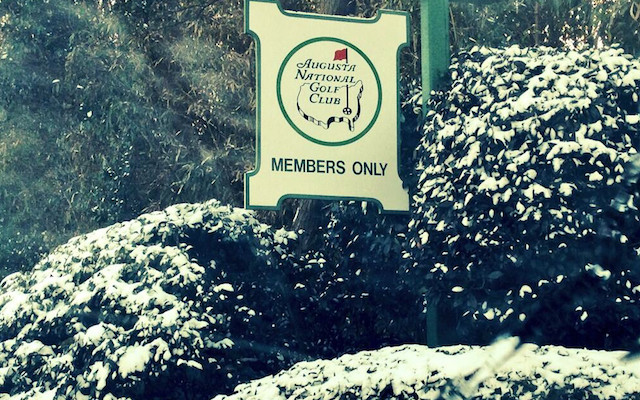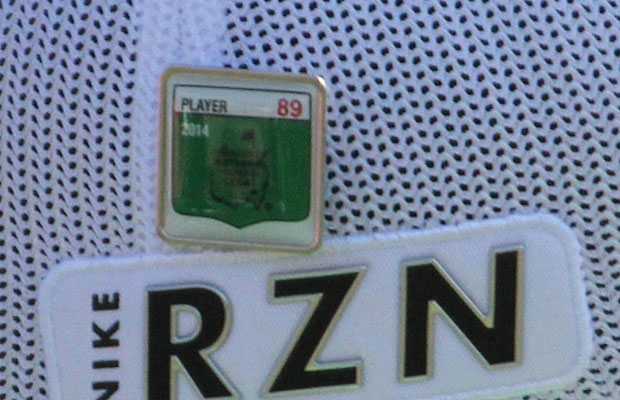Opinion & Analysis
Football is over, so bring on the Masters!

Super Bowl Sunday came and went with a lackluster performance by the league’s top offense and a textbook result for the best defense. At least a good halftime show highlighted the night where the game play and commercials were overall below par. It’s time to move on, time to look forward to the golf season, warmer temperatures, golf on Sundays, fluffy white sand and the Masters.
A blanket of snow and ice fell on Augusta this month producing some of the best photos of Magnolia Lane I have seen. We can now look forward to the blooming of the azaleas and the year’s first major. Augusta will be full of great stories in 2014: Will Tiger break his major winless streak; will Rory rise back to the top; will Lee Westwood finally win a major and the newest story, the first father-son combination to compete together at the Masters. With Kevin Stadler’s win this past weekend, he received an invite to the Masters, where he will join his father and past champion, Craig, in April. Craig announced this will be his last trip to Augusta to play and what better way to go out than playing with your son!
This brings me to my story — this year will my first time making the pilgrimage to Augusta, Ga., to see the beauty that is the Masters. Along for the ride will be my father and best friends. My father helped to spawn my obsession with golf, my love for the beautiful game, and there was no better way to spend an April day than with him and the majestic oasis known as Augusta National.
As I entered the lottery for the first time, I won four tickets to Wednesday’s practice round/par-3 contest. When I received that email notifying me of the chance to purchase the tickets, it was a dream come true. It’s one of those surreal moments when you realize, wow, I actually won something! I immediately called my wife, saying “Sorry, but I will be gone on a dream vacation in April…to watch golf,” followed by a phone call to my father, informing him that we were going. Hotel was booked the next day and everything is set for this bucket list item to take place.
Wednesday, April 9, 2014 will also mark the eight-year anniversary of the death of my grandfather, who loved the game more than I do now. Every April comes with excitement of the Masters but follows with pain of losing him. We were supposed to watch the first round together the following day; instead I receive a phone call that he passed over night. My grandfather and I played golf several times a year, always enjoying each other’s company, talking about his life and the amazing stories he had. He would have been the first person I asked to accompany me this year; instead we will remember his life at one of the most sacred places in golf.
Now that football is over and with only 75 days until our travels begin, Augusta is calling our names. Pictures will be taken (thankfully cameras are allowed on Wednesday), pints will be drank, stories will be shared and new stories will be created. The bond between father and son will not only be shared by the Stadlers this April, but with my father, my grandfather and I.
Opinion & Analysis
The 2 primary challenges golf equipment companies face

As the editor-in-chief of this website and an observer of the GolfWRX forums and other online golf equipment discourse for over a decade, I’m pretty well attuned to the grunts and grumbles of a significant portion of the golf equipment purchasing spectrum. And before you accuse me of lording above all in some digital ivory tower, I’d like to offer that I worked at golf courses (public and private) for years prior to picking up my pen, so I’m well-versed in the non-degenerate golf equipment consumers out there. I touched (green)grass (retail)!
Complaints about the ills of and related to the OEMs usually follow some version of: Product cycles are too short for real innovation, tour equipment isn’t the same as retail (which is largely not true, by the way), too much is invested in marketing and not enough in R&D, top staffer X hasn’t even put the new driver in play, so it’s obviously not superior to the previous generation, prices are too high, and on and on.
Without digging into the merits of any of these claims, which I believe are mostly red herrings, I’d like to bring into view of our rangefinder what I believe to be the two primary difficulties golf equipment companies face.
One: As Terry Koehler, back when he was the CEO of Ben Hogan, told me at the time of the Ft Worth irons launch, if you can’t regularly hit the golf ball in a coin-sized area in the middle of the face, there’s not a ton that iron technology can do for you. Now, this is less true now with respect to irons than when he said it, and is less and less true by degrees as the clubs get larger (utilities, fairways, hybrids, drivers), but there remains a great deal of golf equipment truth in that statement. Think about it — which is to say, in TL;DR fashion, get lessons from a qualified instructor who will teach you about the fundamentals of repeatable impact and how the golf swing works, not just offer band-aid fixes. If you can’t repeatably deliver the golf club to the golf ball in something resembling the manner it was designed for, how can you expect to be getting the most out of the club — put another way, the maximum value from your investment?
Similarly, game improvement equipment can only improve your game if you game it. In other words, get fit for the clubs you ought to be playing rather than filling the bag with the ones you wish you could hit or used to be able to hit. Of course, don’t do this if you don’t care about performance and just want to hit a forged blade while playing off an 18 handicap. That’s absolutely fine. There were plenty of members in clubs back in the day playing Hogan Apex or Mizuno MP-32 irons who had no business doing so from a ballstriking standpoint, but they enjoyed their look, feel, and complementary qualities to their Gatsby hats and cashmere sweaters. Do what brings you a measure of joy in this maddening game.
Now, the second issue. This is not a plea for non-conforming equipment; rather, it is a statement of fact. USGA/R&A limits on every facet of golf equipment are detrimental to golf equipment manufacturers. Sure, you know this, but do you think about it as it applies to almost every element of equipment? A 500cc driver would be inherently more forgiving than a 460cc, as one with a COR measurement in excess of 0.83. 50-inch shafts. Box grooves. And on and on.
Would fewer regulations be objectively bad for the game? Would this erode its soul? Fortunately, that’s beside the point of this exercise, which is merely to point out the facts. The fact, in this case, is that equipment restrictions and regulations are the slaughterbench of an abundance of innovation in the golf equipment space. Is this for the best? Well, now I’ve asked the question twice and might as well give a partial response, I guess my answer to that would be, “It depends on what type of golf you’re playing and who you’re playing it with.”
For my part, I don’t mind embarrassing myself with vintage blades and persimmons chasing after the quasi-spiritual elevation of a well-struck shot, but that’s just me. Plenty of folks don’t give a damn if their grooves are conforming. Plenty of folks think the folks in Liberty Corner ought to add a prison to the museum for such offences. And those are just a few of the considerations for the amateur game — which doesn’t get inside the gallery ropes of the pro game…
Different strokes in the game of golf, in my humble opinion.
Anyway, I believe equipment company engineers are genuinely trying to build better equipment year over year. The marketing departments are trying to find ways to make this equipment appeal to the broadest segment of the golf market possible. All of this against (1) the backdrop of — at least for now — firm product cycles. And golfers who, with their ~15 average handicap (men), for the most part, are not striping the golf ball like Tiger in his prime and seem to have less and less time year over year to practice and improve. (2) Regulations that massively restrict what they’re able to do…
That’s the landscape as I see it and the real headwinds for golf equipment companies. No doubt, there’s more I haven’t considered, but I think the previous is a better — and better faith — point of departure when formulating any serious commentary on the golf equipment world than some of the more cynical and conspiratorial takes I hear.
Agree? Disagree? Think I’m worthy of an Adam Hadwin-esque security guard tackle? Let me know in the comments.
@golfoncbs The infamous Adam Hadwin tackle ? #golf #fyp #canada #pgatour #adamhadwin ? Ghibli-style nostalgic waltz – MaSssuguMusic
Podcasts
Fore Love of Golf: Introducing a new club concept

Episode #16 brings us Cliff McKinney. Cliff is the founder of Old Charlie Golf Club, a new club, and concept, to be built in the Florida panhandle. The model is quite interesting and aims to make great, private golf more affordable. We hope you enjoy the show!
Opinion & Analysis
On Scottie Scheffler wondering ‘What’s the point of winning?’

Last week, I came across a reel from BBC Sport on Instagram featuring Scottie Scheffler speaking to the media ahead of The Open at Royal Portrush. In it, he shared that he often wonders what the point is of wanting to win tournaments so badly — especially when he knows, deep down, that it doesn’t lead to a truly fulfilling life.
View this post on Instagram
“Is it great to be able to win tournaments and to accomplish the things I have in the game of golf? Yeah, it brings tears to my eyes just to think about it because I’ve literally worked my entire life to be good at this sport,” Scheffler said. “To have that kind of sense of accomplishment, I think, is a pretty cool feeling. To get to live out your dreams is very special, but at the end of the day, I’m not out here to inspire the next generation of golfers. I’m not out here to inspire someone to be the best player in the world, because what’s the point?”
Ironically — or perhaps perfectly — he went on to win the claret jug.
That question — what’s the point of winning? — cuts straight to the heart of the human journey.
As someone who’s spent over two decades in the trenches of professional golf, and in deep study of the mental, emotional, and spiritual dimensions of the game, I see Scottie’s inner conflict as a sign of soul evolution in motion.
I came to golf late. I wasn’t a junior standout or college All-American. At 27, I left a steady corporate job to see if I could be on the PGA Tour starting as a 14-handicap, average-length hitter. Over the years, my journey has been defined less by trophies and more by the relentless effort to navigate the deeply inequitable and gated system of professional golf — an effort that ultimately turned inward and helped me evolve as both a golfer and a person.
One perspective that helped me make sense of this inner dissonance around competition and our culture’s tendency to overvalue winning is the idea of soul evolution.
The University of Virginia’s Division of Perceptual Studies has done extensive research on reincarnation, and Netflix’s Surviving Death (Episode 6) explores the topic, too. Whether you take it literally or metaphorically, the idea that we’re on a long arc of growth — from beginner to sage elder — offers a profound perspective.
If you accept the premise literally, then terms like “young soul” and “old soul” start to hold meaning. However, even if we set the word “soul” aside, it’s easy to see that different levels of life experience produce different worldviews.
Newer souls — or people in earlier stages of their development — may be curious and kind but still lack discernment or depth. There is a naivety, and they don’t yet question as deeply, tending to see things in black and white, partly because certainty feels safer than confronting the unknown.
As we gain more experience, we begin to experiment. We test limits. We chase extreme external goals — sometimes at the expense of health, relationships, or inner peace — still operating from hunger, ambition, and the fragility of the ego.
It’s a necessary stage, but often a turbulent and unfulfilling one.
David Duval fell off the map after reaching World No. 1. Bubba Watson had his own “Is this it?” moment with his caddie, Ted Scott, after winning the Masters.
In Aaron Rodgers: Enigma, reflecting on his 2011 Super Bowl win, Rodgers said:
“Now I’ve accomplished the only thing that I really, really wanted to do in my life. Now what? I was like, ‘Did I aim at the wrong thing? Did I spend too much time thinking about stuff that ultimately doesn’t give you true happiness?’”
Jim Carrey once said, “I think everybody should get rich and famous and do everything they ever dreamed of so they can see that it’s not the answer.”
Eventually, though, something shifts.
We begin to see in shades of gray. Winning, dominating, accumulating—these pursuits lose their shine. The rewards feel more fleeting. Living in a constant state of fight-or-flight makes us feel alive, yes, but not happy and joyful.
Compassion begins to replace ambition. Love, presence, and gratitude become more fulfilling than status, profits, or trophies. We crave balance over burnout. Collaboration over competition. Meaning over metrics.
Interestingly, if we zoom out, we can apply this same model to nations and cultures. Countries, like people, have a collective “soul stage” made up of the individuals within them.
Take the United States, for example. I’d place it as a mid-level soul: highly competitive and deeply driven, but still learning emotional maturity. Still uncomfortable with nuance. Still believing that more is always better. Despite its global wins, the U.S. currently ranks just 23rd in happiness (as of 2025). You might liken it to a gifted teenager—bold, eager, and ambitious, but angsty and still figuring out how to live well and in balance. As much as a parent wants to protect their child, sometimes the child has to make their own mistakes to truly grow.
So when Scottie Scheffler wonders what the point of winning is, I don’t see someone losing strength.
I see someone evolving.
He’s beginning to look beyond the leaderboard. Beyond metrics of success that carry a lower vibration. And yet, in a poetic twist, Scheffler did go on to win The Open. But that only reinforces the point: even at the pinnacle, the question remains. And if more of us in the golf and sports world — and in U.S. culture at large — started asking similar questions, we might discover that the more meaningful trophy isn’t about accumulating or beating others at all costs.
It’s about awakening and evolving to something more than winning could ever promise.



















hokieputter
Feb 5, 2014 at 9:28 pm
Ben, it will be an amazing trip. I made my first trip last year. Same situation. Wednesday tickets from the lottery. Went with my dad and brother. Wouldn’t have wanted to be there for the first time with anyone else. Absolutely incredible. Can’t wait to get back. Enjoy!
Ben Snyder
Feb 6, 2014 at 9:47 am
Thanks for the remarks, hokieputter. Can’t wait, should be amazing. Any suggestions on where to go first, what to do?
Richard L Cox III
Feb 6, 2014 at 12:14 pm
Ben,
Let me know when you get into town. Maybe we can meet up during the week (if you’re still there during the tournament rounds).
Wednesday is one of the neatest days to experience. Although you won’t be able to see much golf on the big course, it gives you a chance to be much more intimate with some of the players out there. You can also take in the best day to watch the players at the practice facility. The range will blow you away.
If you’re really ready to see as much as you can in one day, here’s what I’d recommend:
7:30 am-wherever you’re staying, make sure that you’re getting near the golf course at about this time. Today’s traffic will be the worst of the week. Get there early. I can show you a back way to get to the biggest “patron” lot (if you have the credential for it) on Berckman’s Road if you message me.
8 am- I’m counting on you to be going through the gate at this time. Be prepared for an Airport-like security check…my strategy would be to try and go through the line closest to the ‘PGA member’ line (all the way to the left) because most people crowd around the three middle lines and don’t even realize that there are almost two dozen lines available.
As soon as you go through the line, I would make a bee-line to the merchandise tent. Be decisive, be committed. This is like getting around in a subway. Buy what you want and then immediately exit left to the bag check line. It might take you fifteen minutes to do this, but you’ll thank me later when you notice that you aren’t lugging around all of that crap you just bought the entire day. The system is extremely efficient and it’s just plain worth it.
9am- get to the course. Go straight towards the clubhouse, and take a left up the hill in the direction of the Veranda and the first tee. Go past it to the putting green, and head to the back nine. This way you bypass a lot of the traffic that’s not sure how to navigate the course. Go down the tenth fairway and follow the back nine in order through Amen Corner. (do NOT forget to stop and get a beer at the concession stand beside the eleventh/fourteenth)
by 10am you should be behind 13 green/14 tee. Take a couple of tee shots on 14 if you can. Walk up to the 14th green (one of the best on the course) and, maybe, walk across to the previous concession area and reload.
Walk down 15, and go to 16 tee. Make sure you go to the left side of sixteen. There is a new walkway that goes to the hill left of the pond (and leads you up to the 6th tee) that provides one of the neatest views of the golf course. You can view 5,6,15,16, and take in a general view of the scenery. (I’m talking about women here…prepare yourself)
At this point, we’re nearing the time for a feeding. Make your way up the hill to six tee, and then cross the fifth fairway and retire to the large concession area behind the fifth green. There’s ample seating, phone booths, a bathroom, and the guarantee that you will not be in the most populated concession area on the course. It’s a little oasis back there. You shouldn’t miss it. Go for the gusto, one egg salad and one pimiento cheese. You are not allowed to have the chicken sandwich.
After your fueling stop, go backwards down the fifth fairway to the fourth hole. Stand behind the fourth tee for a bit, where you can see the third, second, and seventh. You also start to comprehend how delightfully compact the property is, even though it seems like it’s miles wide because of the terrain.
Go back up the third hole to the second green. Look back up the fairway and notice the ridiculous elevation change. Look behind you at the seventh, and down the eighth fairway. Go up the eighth to the green, and cut over to look down the first fairway. Take in a tee shot or two on the ninth.
Go down the left side of the ninth hole, and take in the uphill approach. Cut across the first fairway and make your way to the eighteenth green. Imagine what will transpire four days from then.
At this point, you may want to wander back to the practice range. People will be warming up for the Par Three contest, or just going about their routines. Stay there until about half an hour before the contest starts, and make your way to the Par Three course. (past the putting green on your left-hand side)
At the Par Three contest, there’s really no good strategy for watching golf, other than to walk all nine holes. If nothing else, you can see why people call it “the best golf course at ANGC.” The roughly 870 yards of the par three course are some of the most breathtaking short shots you’ll ever see. Make sure you find a way to watch at least a few shots into the ninth. That may be my favorite shot to watch at the National.
Finish your day any way you please, but try to wander around the putting green/Veranda area, and just watch the guys in their final preparations for the tournament. Look for celebrities, look for Fortune 500 CEO’s, look for the pro’s wives (this is the best), or just look around.
Don’t forget your merchandise at the bag-check.
Feel free to message me if you have any questions.
Double Mocha Man
Feb 5, 2014 at 12:50 pm
Good job. Well-written. Touching. Love the pics of Augusta National as we’ve never seen it before.
Just a couple weeks before pitchers and catchers report for Spring Training!
(Seattle expects up to half a million fans lining the parade route today)
Ben Snyder
Feb 6, 2014 at 9:49 am
DMM, Thanks for the comments! Saw the photos on twitter, and had to write about it! Maybe my cubbies will finally win…..dreaming.